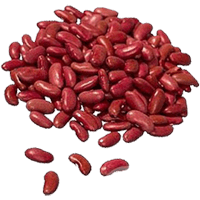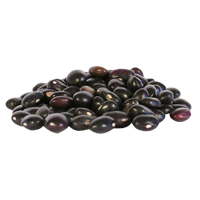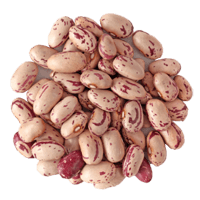Adzuki Bean: In-Depth Nutrition, Diets, Health, & More
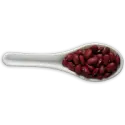
Summary
Adzuki beans are alkaline-forming foods, low in calories and glycemic index (GI), rich in proteins, dietary fiber, phytochemicals, low in net carbs, and nearly absent in fats. Adzuki beans are rich in folate (vitamin B9), vitamins B1 and B5, copper, iron, phosphorus, and manganese. The beans also contain certain amounts of several antinutrients, mainly phytates, α-galactosides, and trypsin inhibitors.
Adzuki beans contain 25mg of oxalates; therefore, their consumption should be limited for people at risk of kidney stones.
Table of contents
- Introduction
- Varieties
- Nutrition
- Serving Size
- Glycemic Index
- Acidity
- Weight Loss and Diets
- Health Impact
- Cooking and Use
- Storage, Keeping, and Conservation
- History
- Cultivation and Botany
- Production and Consumption
- References
Introduction
Adzuki beans, otherwise known as red beans, red mung beans, red chori, or sweet beans, are small and round beans that are incredibly rich in nutrients. These beans are mostly grown in East Asia but are used worldwide.
In this article, we will discuss the properties of adzuki beans in detail, with a central focus on their nutrients and impact on health, as well as looking at some of the bean’s historical and economic aspects.
Classification
The scientific name for the adzuki bean species is Vigna angularis. These beans belong to the Vigna genus and the Fabaceae family.
The Fabaceae family is also known as the bean, legume, or pea family. Adzuki beans share this family with other well-known crops, such as common beans, soybeans, peas, chickpeas, peanuts, licorice, etc.
The Vigna genus that adzuki beans belong to also includes the black gram, the cowpea, and the mung bean species. If interested, you can read our complete nutrition and health benefits analysis for black gram.
The adzuki bean plant is believed to be domesticated from its wild progenitor, Vigna angularis var. Nipponensis (1).
Taste and Appearance
Adzuki beans are round and small in size. The average adzuki bean is about 7mm in length and 5mm in width (2). These beans have a small hilum, a seed scar, on the sides.
These beans can come in various colors, such as black, white, grey, or spotted. However, the most widely used adzuki beans are the red beans.
Adzuki beans have a nutty and mildly sweet taste. Due to the mild taste, adzuki beans work well in the kitchen with various spices. The sweetness of adzuki beans is often used as bean paste in confectionery and bakery products.
Varieties
Varieties of adzuki beans can have somewhat different nutrient levels, physical properties, and cooking requirements.
Depending on the variety, the adzuki beans can have seed coats of varying shades and colors. The seed coat color has been studied to be correlated with the amount of sunshine on the seed, as well as the temperature and the growing period. The more sunshine the seed absorbs, the darker it becomes (3).
The leading variety of adzuki beans in Japan is the Erimoshouzu variety, while the main variety in Australia is the Bloodwood variety (4).
Some other varieties of adzuki beans include the Japanese Red, the Chinese Red, the Adzuki Express, the Takara, and the Minoka (5).
In the US, the most widely grown variety in the Upper Midwest is the Takara, first imported from Japan in 1978. The Minoka variety, a large-seeded adzuki bean, was released by the Minnesota Agricultural Experiment Station in 1980 but has not been widely grown (6).
Nutrition
Naturally, the nutrition of adzuki beans can differ depending on the variety and cooking method. In this article, we will be focusing on mature adzuki bean seeds boiled without salt. For comparison, we will also use raw, mature adzuki beans and sweetened, canned, mature adzuki beans (7, 8).
Red adzuki beans are not to be confused with red kidney beans. On our "Adzuki beans vs. Kidney beans" page, you can find an in-depth nutrition comparison of the two red beans.
Macronutrients and Calories
Adzuki beans are dense in nutrients, with boiled adzuki beans comprising 66.3% water and 33.7% nutrients. Raw adzuki beans are even more nutritionally dense, containing only 13.4% water and 86.6% nutrients.
Sweetened, canned adzuki beans are denser than boiled beans but less dense than dry ones. Canned adzuki beans consist of 40.6% water and 59.4% nutrients.
Macronutrients chart
Calories
A 100g serving of cooked adzuki beans provides 128 calories. The same serving size of canned, sweetened adzuki beans contains almost double the number of calories - 237.
However, being the most dense in nutrients, raw beans provide 329 calories per 100g serving.
One average serving size of cooked adzuki beans is 130g. Therefore, an average serving size of boiled beans provides 166 calories, while the average serving size of sweetened, canned beans contains 308 calories.
Protein
Adzuki beans are incredibly rich in protein, providing 7.52g of protein per every 100g serving. The same amount of adzuki beans covers around 18% of the recommended daily value of this nutrient.
Adzuki bean's protein is of good quality, as it contains some levels of all essential amino acids. A 100g of boiled adzuki beans cover more than 20% of the recommended daily values for all the essential amino acids except for methionine, which is covered by 8%.
Protein quality breakdown
Of the non-essential amino acids, adzuki beans are rich in glutamic acid.
Raw adzuki beans are naturally significantly higher in protein, containing about 20g of it in a 100g serving.
Sweetened, canned adzuki beans, on the other hand, are about 2 times lower in protein compared to boiled adzuki beans. A 100g serving of sweetened, canned adzuki beans contains 3.8g of protein.
Fats
Adzuki beans are very low in fats, containing 0.1g of fats in a 100g serving.
Raw adzuki beans contain 0.53g of fats in a 100g serving, while sweetened, canned adzuki beans contain 0.03g of fats.
As plant products, adzuki beans naturally contain no cholesterol.
Carbohydrates
Adzuki beans are high in carbohydrates due to their rich dietary fiber content. A 100g serving of boiled adzuki beans contains 25g of carbohydrates, 7.3g of which is dietary fiber.
Adzuki beans are very low in simple sugars. Most of the carbohydrates in adzuki beans consist of total starch, such as resistant starch and amylose (9).
Raw and sweetened, canned adzuki beans are unsurprisingly significantly higher in carbohydrates, containing 63g and 55g of carbohydrates, respectively, in 100g serving sizes.
Macronutrient Comparison Table of Various Beans
The comparison table below is calculated for 100g of each bean.
| Calories | Protein | Fat | Total Carbs | Fiber | |
| Adzuki | 128 | 7.52g | 0.1g | 24.77g | 7.3g |
| Pinto | 143 | 9.0g | 0.65g | 26.22g | 9g |
| Fava | 110 | 7.6g | 0.4g | 19.65g | 5.4g |
| Kidney | 127 | 8.67g | 0.5g | 22.8g | 6.4g |
| Black Turtle | 130 | 8.18g | 0.35g | 24.35g | 8.3g |
| Navy | 140 | 8.23g | 0.62g | 26.05g | 10.5g |
| Great Northern | 118 | 8.33g | 0.45g | 21.09g | 7g |
Vitamins
Adzuki beans are abundant in folate or vitamin B9, falling in the top 22% of foods as a source of this vitamin. 100g of cooked adzuki beans cover 30% of the recommended daily value of this vitamin.
These beans are also rich in vitamin B1 (thiamine) and vitamin B5 (pantothenic acid).
Adzuki beans contain a moderate amount of vitamins B2, B3, and B6 and trace amounts of vitamin A.
These beans are completely absent in vitamins B12, D, and C.
Raw beans, being denser in nutrients, are richer in all these vitamins. However, canned adzuki beans tend to have slightly lower levels of vitamins.
Vitamin coverage chart
Minerals
Adzuki beans are particularly rich in copper; 100g serving covers the recommended daily value (DV) by 33%. They are also rich in manganese, iron, and potassium; each mineral covers the DV by 25%.
Adzuki beans are a good source of magnesium, potassium, and zinc. They also contain low amounts of calcium and selenium.
Adzuki beans fall in the top 12% of foods as a source of potassium, in the top 21% of foods as a source of magnesium, and in the top 25% as a source of copper.
Unsalted, boiled adzuki beans are low in sodium, containing 8mg of it in a 100g serving.
Mineral coverage chart
Oxalates
The oxalate content of Adzuki beans is 25mg per 100g serving. This amount of oxalates (oxalic acids) is considered low for most people but high for people at risk of developing calcium oxalate kidney stones. Consequently, adzuki bean consumption should be limited for people at risk.
Phytochemicals
Phytochemicals, or phytonutrients, are biologically active plant compounds abundant in beans. The main phytochemicals in adzuki beans are procyanidins, anthocyanins, saponins, flavonoids, flavones, tannins, etc. (10, 11). They are partially responsible for the health benefits of adzuki beans.
Most phytochemicals act as antioxidants and reduce cell damage caused by harmful free radicals, reducing the risk of cancer and chronic diseases.
Various subtypes of polyphenols (flavonoids, flavones, anthocyanins), saponins, dietary fiber, and resistant starch are good for heart health, blood sugar control, digestion, and overall metabolic profile. They may help against inflammation, parasitic and microbial infections, and allergies and protect the liver and kidneys (11, 12).
Serving Size
According to the FDA, the average serving size of beans per person is 130g for beans in sauce or canned in liquid and refried beans, 90g for beans prepared otherwise, and 35g for dry beans (13).
Glycemic Index
The glycemic index of red adzuki beans steamed for 70 minutes has been measured to be 29, and steamed for 40 minutes - 21 (14). This shows that despite the high carbohydrate content, the glycemic index of adzuki beans falls in the low category due to the high fiber and low simple sugar content.
A study has also been carried out about the glycemic index of adzuki bean powders, focusing on different preparation methods. It was found that the adzuki bean powder prepared by roller cooking, a process including milling and mashing the beans into the powder, had the highest estimated glycemic index of 80. At the same time, adzuki bean powder prepared by extruded cooking and steamed cooking had estimated glycemic index values of 70 and 50, respectively (15).
Acidity
Beans are known to be alkaline-forming foods and can be used as a source of protein for those avoiding acidic foods, such as meat and dairy.
Adzuki beans have been calculated to have a PRAL value of -6.7, showing that these beans are alkaline-producing.
The PRAL value or the potential renal acid load value of the food demonstrates how much acid or base the food produces in the body. The bigger the negative PRAL number is, the more alkaline-forming the food.
Weight Loss and Diets
Adzuki beans are high in dietary fiber, resistant starch, and protein, and low in fats and simple sugars; thus, they can fit well in healthy weight-loss diets.
Black adzuki beans have been researched to have a positive effect on diet-induced obesity, as they improve the lipid profile and decrease body weight (16).
Multiple other studies have demonstrated that the anti-obesity properties of adzuki beans are due to their high polyphenol content, mainly saponins and flavonoids (17, 18, 19).
| Keto | Adzuki beans are high in carbohydrates but low in sugars. Adzuki beans can be used on a keto diet but only in strict moderation. |
| DASH | A DASH diet recommends including foods that are high in potassium, magnesium, calcium, fiber, and protein whilst being low in sodium and saturated fats (20). Fitting all the recommendations, adzuki beans are perfect for this diet. On this diet, adding a minimal amount of salt is allowed when boiling adzuki beans. |
| Atkins | Adzuki beans are to be avoided during the initial Induction phase of the Atkins diet. During the second or the Balancing phase, adzuki beans are to be used only in strict moderation. For example, half a serving of adzuki beans can be consumed daily. The third and fourth phases, known as Pre-maintenance and Lifelong maintenance, allow a higher intake of carbs; however, adzuki beans should still be consumed mindfully. |
| Mediterranean | While the adzuki bean originated in East Asia, it can still be consumed on a Mediterranean diet. |
| Paleo | Beans are a controversial topic on the paleo diet. Besides the question of not being domesticated during the Paleolithic age, beans also include toxic antinutrients such as phytic acid and lectins (21). As a result, adzuki beans are not considered to be part of the paleo diet. |
| Vegan/ Vegetarian/ Pescetarian | Adzuki beans can play an important role as an alternative source of protein for people on these diets. |
| Gluten-free | Adzuki beans do not contain gluten. |
| Dukan | Adzuki beans are not allowed during the first and second or Attack and Cruise phases of this diet. Starchy foods, such as adzuki beans, can be slowly added during the third or Consolidation phase and used throughout the fourth or Stabilization phase. |
| Intermittent Fasting | Like most other foods, adzuki beans can be consumed during the eating periods but not during the fasting phases. |
| Low Fat & Low Calorie | Adzuki beans are very low in fats and calories. However, sweetened, canned adzuki beans are higher in calories and should be limited. |
| Low GI | Adzuki beans are a good fit for low glycemic index diets, as these beans have a low glycemic index of 26. |
| Anti Inflammatory | Beans overall fit into anti-inflammatory diets due to their high antioxidant, protein, and fiber contents. Adzuki beans have also been studied to possess certain anti-inflammatory qualities (9, 12, 22) |
| BRAT | It is recommended to avoid adzuki beans on a BRAT diet, as they are high in indigestible fiber, which may cause gas, flatulence, and worsen diarrhea. |
| Low FODMAP | Adzuki beans contain some levels of FODMAPs, carbs undergoing bacterial fermentation in the large intestine and causing gastrointestinal symptoms. Adzuki beans can be consumed only in moderation. |
Health Impact
The nutritional characteristics mentioned above, along with other aspects, give adzuki beans qualities that impact health either negatively or positively. In this section, we will go over these qualities by analyzing the scientific research available.
Health Benefits
Cardiovascular Health
Studies on animals have shown adzuki bean extract to reduce triglyceride, total cholesterol, and LDL cholesterol levels and decrease systolic blood pressure, as well as decrease liver fat and markers of liver damage. Adzuki bean extract may lower blood pressure by decreasing the enzyme level partially responsible for the constriction of blood vessels (23, 24).
Improving blood lipid and blood pressure levels may help decrease the risk of various cardiovascular diseases, such as atherosclerosis, cardiac arrest, and stroke.
Diabetes
As mentioned above, adzuki beans have a low glycemic index and can be used in a diabetes diet plan.
One study researching the effects of extruded adzuki bean convenient food showed the diet to improve glycemic control and ameliorate inflammation in people with type 2 diabetes (14).
Raw and cooked adzuki beans have been found to help improve glucose tolerance while also preventing liver and pancreatic damage in diabetic patients. Raw adzuki beans contain a higher level of beneficial phytochemicals that help reduce fasting blood sugar levels (25).
Adzuki bean extract has also demonstrated inhibiting effects on α-glycosidase (9). α-glycosidase is an enzyme involved in glucose absorption from the intestines.
Cancer
The adzuki bean has exhibited strong antiproliferative effects on digestive system cancer cells, as well as ovary and breast cancer cell lines (26).
The heat-stable adzuki bean extract has also been studied as a promising immune-enhancing food and dietary supplement for cancer prevention. These beans may potentially stimulate the differentiation of bone marrow cells into immature dendritic cells. Dendritic cells play an important role in the immune system fighting cancer. Furthermore, adzuki beans can inhibit the growth of leukemia cancer cell lines by inducing cell death (27).
Digestive Health
Being rich in dietary fiber and resistant starch, adzuki beans have been researched to improve gut microbiota composition, as well as ameliorating high-fat diet-induced obesity (17, 28).
Black adzuki beans can also attenuate colon inflammation by improving mucosal barrier protection, reducing endotoxemia, and decreasing inflammatory cytokines (22).
Downsides and Risks
Cancer
Despite the numerous beneficial cancer-preventive effects of adzuki beans, they may have a negative effect on estrogen receptor-positive (ER+) breast cancer. Ethanol extract of adzuki beans has been studied to have estrogen-like activities that may stimulate the proliferation of breast cancer cells (29).
Antinutrients
Like most beans, raw adzuki beans contain certain amounts of antinutrient compounds that can reduce the intestine’s ability to absorb some of the essential nutrients.
The primary antinutrients found in adzuki beans are phytates, α-galactosides, and trypsin inhibitors (30).
Phytates can decrease the absorption of iron, zinc, magnesium, and calcium (31). The trypsin inhibitors can worsen the breakdown and subsequent absorption of proteins.
However, most of the antinutrients can be removed or deactivated by soaking, sprouting, or cooking the beans. The nutrient benefits greatly outweigh the negative effects of the antinutrients (31).
Allergy
Despite the anti-allergic properties, cases of adzuki bean allergy have been reported. However, it is extremely rare and underresearched (32).
Cooking and Use
Adzuki beans are most popular in East Asian cuisine, where these beans can be used to make savory foods but are more often used in confectionaries. Adzuki beans are slightly sweeter than most similar bean crops.
These beans are usually used in confectionery as red bean paste or adzuki flour. Red bean paste is also called red bean jam, adzuki bean paste, or anko. It is made by mashing or grinding boiled adzuki beans, with or without adding sweeteners like sugar or honey. Red bean paste can be used for fillings and toppings in desserts.
Adzuki beans have been used to make traditional Japanese confections, such as wagashi, youkan, manju, and amanatto, and the paste can also be used to make Japanese mochi (33).
Adzuki bean flour can be used to make noodles. They can be popped like popcorn, used as a beverage base, or as a substitute for coffee. A rice and adzuki bean dish, called sekihan, is often served on festive occasions, such as weddings and birthdays (34).
These beans can be fermented and used to make Japanese natto.
Adzuki beans may even be used to make vegan bacon.
Other beans, such as red kidney or black turtle beans, can be used as a substitute for adzuki beans in savory meals. However, it is difficult to find a substitute for adzuki beans in desserts and pastries.
Storage, Keeping, and Conservation
Raw adzuki beans should be stored in a cool, dark, and dry space, preferably in airtight containers.
The perfect conditions for preserving adzuki beans have been researched to be 50°F (10°C) and 65% relative humidity. Storage at a higher temperature or lower humidity resulted in a significant loss of bean moisture, increased hydration times, and hardness of the cooked beans (35).
Adzuki beans usually have an average shelf life of one year. Colder temperatures increase the shelf life.
History
The geographical origin of domesticated adzuki beans is generally considered to be Northeast Asia, while a specific location has not yet been specified. It has been suggested that China may have been the primary origin. However, earlier records have been found from Japan and Korea (36).
Japan is regarded as the center of the genetic diversity of adzuki and a possible origin of its domestication. The domestication of adzuki beans may have initiated a size increase of the bean (36).
Historic texts describe the relatively late occurrence of adzuki beans compared with other crops, first appearing in the Eastern Zhou around 2 to 3 thousand years ago (36).
Cultivation and Botany
The adzuki bean plant, or Vigna angularis, is an annual vine. The growth conditions for this plant are similar to that of soybean plants. It is moderately drought tolerant and can be grown in various soils, including silt loams and sandy soils. The adzuki plant does not, however, tolerate water-logged soils and competes poorly with weeds (34).
The adzuki bean plant prefers soil with a neutral pH value. This plant seeds in the late spring. The warmer the climate, the faster the plant will emerge (34).
Production and Consumption
In 2019, the world export of adzuki beans exceeded $147 million, having grown by $21 million from the previous year (37).
The world’s largest exporter of adzuki beans is China, responsible for about 40% of world exports. After China, the world’s largest exporters of adzuki beans are Canada, Brazil, and the Kyrgyz Republic (37).
However, the world’s largest bean importer is Japan, importing about 28% of the world’s imports. The largest importers of adzuki beans also include Afghanistan, Korea, and China (37).
References
- https://www.jstor.org/stable/4255464
- Azuki bean sizes (mm)
- https://www.tandfonline.com/doi/pdf/10.1626/pps.3.61
- https://www.jstage.jst.go.jp/article/cookeryscience1995/33/2/33_257/_pdf/-char/en
- https://gms.ctahr.hawaii.edu/gs/handler/getmedia.ashx?moid=3262&dt=3&g=12
- https://hort.purdue.edu/newcrop/afcm/adzuki.html
- https://fdc.nal.usda.gov/fdc-app.html#/food-details/173727/nutrients
- https://fdc.nal.usda.gov/fdc-app.html#/food-details/173729/nutrients
- https://www.tandfonline.com/doi/full/10.1080/09540105.2016.1208152
- https://pubmed.ncbi.nlm.nih.gov/26868587/
- https://www.sciencedirect.com/science/article/pii/S2666154322001314
- https://www.ncbi.nlm.nih.gov/pmc/articles/PMC9862941/
- https://www.fda.gov/media/102587/download
- https://www.sciencedirect.com/science/article/pii/S0002916522004944
- https://www.researchgate.net/publication/353426834
- https://www.ncbi.nlm.nih.gov/pmc/articles/PMC4615815/
- https://pubmed.ncbi.nlm.nih.gov/31574574/
- https://www.frontiersin.org/articles/10.3389/fphar.2017.00687/full
- https://www.researchgate.net/publication/223977062
- https://www.nhlbi.nih.gov/health-topics/dash-eating-plan
- https://thepaleodiet.com/beans-and-legumes-are-they-paleo
- https://pubmed.ncbi.nlm.nih.gov/28406732/
- https://pubmed.ncbi.nlm.nih.gov/34359440/
- https://www.researchgate.net/publication/305689595
- https://onlinelibrary.wiley.com/doi/abs/10.1002/cche.10456
- https://pubmed.ncbi.nlm.nih.gov/25005945/
- https://pubmed.ncbi.nlm.nih.gov/22524832/
- https://www.mdpi.com/2072-6643/13/9/3240
- https://onlinelibrary.wiley.com/doi/abs/10.1002/ptr.2135
- https://www.phytojournal.com/archives/2019/vol8issue1/PartW/8-1-233-543.pdf
- https://www.hsph.harvard.edu/nutritionsource/anti-nutrients/
- https://www.researchgate.net/publication/283155948
- https://www.researchgate.net/publication/295399061
- https://www.echocommunity.org/en/resources/ee4f352a-5902-43e1-8460-4a1d25e1a4ee.pdf
- https://www.sciencedirect.com/science/article/abs/pii/S0023643801908783
- https://www.researchgate.net/publication/258139145
- https://trendeconomy.com/data/commodity_h2/071332
Top nutrition facts for Adzuki bean

| Calories ⓘ Calories for selected serving | 128 kcal |
|
Glycemic index ⓘ
Source:
Check out our Glycemic index chart page for the full list.
|
29 (low) |
| Glycemic load | 12 (medium) |
| Net Carbs ⓘ Net Carbs = Total Carbohydrates – Fiber – Sugar Alcohols | 17 grams |
| Default serving size ⓘ Serving sizes are mostly taken from FDA's Reference Amounts Customarily Consumed (RACCs) | 1 cup (230 grams) |
| Acidity (Based on PRAL) ⓘ PRAL (Potential renal acid load) is calculated using a formula. On the PRAL scale the higher the positive value, the more is the acidifying effect on the body. The lower the negative value, the higher the alkalinity of the food. 0 is neutral. | -3 (alkaline) |
| Oxalates ⓘ https://www.sciencedirect.com/science/article/abs/pii/S0889157504001243 | 25 mg |
Adzuki bean calories (kcal)
| Calories for different serving sizes of adzuki bean | Calories | Weight |
|---|---|---|
| Calories in 100 grams | 128 | |
| Calories in 1 cup | 294 | 230 g |
| Calories for different varieties of adzuki bean | Calories | Weight |
|---|---|---|
| Beans, adzuki, mature seeds, cooked, boiled, without salt (this food) | 128 | 100 g |
| Beans, baked, canned, plain or vegetarian | 94 | 100 g |
| Beans, baked, canned, with pork and tomato sauce | 94 | 100 g |
| Beans, baked, canned, with pork and sweet sauce | 105 | 100 g |
| Beans, baked, canned, with pork | 106 | 100 g |
| Beans, baked, canned, with beef | 121 | 100 g |
| Beans, adzuki, mature seed, cooked, boiled, with salt | 128 | 100 g |
| Beans, baked, canned, with franks | 142 | 100 g |
| Beans, adzuki, mature seeds, canned, sweetened | 237 | 100 g |
| Adzuki bean | 329 | 100 g |
Adzuki bean Glycemic index (GI)
Adzuki bean Glycemic load (GL)
Mineral chart - relative view
Vitamin chart - relative view
Fat type information
Fiber content ratio for Adzuki bean
All nutrients for Adzuki bean per 100g
| Nutrient | Value | DV% | In TOP % of foods | Comparison |
| Vitamin A | 0µg | 0% | 100% | |
| Calories | 128kcal | 6% | 66% |
2.7 times more than Orange
|
| Protein | 7.5g | 18% | 52% |
2.7 times more than Broccoli
|
| Fats | 0.1g | 0% | 93% |
333.1 times less than Cheese
|
| Vitamin C | 0mg | 0% | 100% |
N/A
|
| Net carbs | 17g | N/A | 34% |
3.1 times less than Chocolate
|
| Carbs | 25g | 8% | 30% |
1.1 times less than Rice
|
| Cholesterol | 0mg | 0% | 100% |
N/A
|
| Vitamin D | 0µg | 0% | 100% |
N/A
|
| Magnesium | 52mg | 12% | 21% |
2.7 times less than Almonds
|
| Calcium | 28mg | 3% | 45% |
4.5 times less than Milk
|
| Potassium | 532mg | 16% | 12% |
3.6 times more than Cucumber
|
| Iron | 2mg | 25% | 37% |
1.3 times less than Beef broiled
|
| Fiber | 7.3g | 29% | 14% |
3 times more than Orange
|
| Copper | 0.3mg | 33% | 25% |
2.1 times more than Shiitake
|
| Zinc | 1.8mg | 16% | 42% |
3.6 times less than Beef broiled
|
| Phosphorus | 168mg | 24% | 48% |
1.1 times less than Chicken meat
|
| Sodium | 8mg | 0% | 87% |
61.3 times less than White bread
|
| Selenium | 1.2µg | 2% | 81% | |
| Manganese | 0.57mg | 25% | 36% | |
| Vitamin B1 | 0.12mg | 10% | 44% |
2.3 times less than Pea raw
|
| Vitamin B2 | 0.06mg | 5% | 77% |
2 times less than Avocado
|
| Vitamin B3 | 0.72mg | 4% | 73% |
13.4 times less than Turkey meat
|
| Vitamin B5 | 0.43mg | 9% | 63% |
2.6 times less than Sunflower seeds
|
| Vitamin B6 | 0.1mg | 7% | 66% |
1.2 times less than Oats
|
| Vitamin B12 | 0µg | 0% | 100% |
N/A
|
| Trans fat | 0g | N/A | 100% |
N/A
|
| Folate | 121µg | 30% | 22% |
2 times more than Brussels sprouts
|
| Saturated fat | 0.04g | 0% | 88% |
163.8 times less than Beef broiled
|
| Monounsaturated fat | 0.01g | N/A | 93% |
1088.8 times less than Avocado
|
| Polyunsaturated fat | 0.02g | N/A | 94% |
2246.4 times less than Walnut
|
| Tryptophan | 0.07mg | 0% | 82% |
4.2 times less than Chicken meat
|
| Threonine | 0.26mg | 0% | 81% |
2.8 times less than Beef broiled
|
| Isoleucine | 0.3mg | 0% | 81% |
3 times less than Salmon raw
|
| Leucine | 0.63mg | 0% | 79% |
3.8 times less than Tuna Bluefin
|
| Lysine | 0.57mg | 0% | 75% |
1.3 times more than Tofu
|
| Methionine | 0.08mg | 0% | 85% |
1.2 times less than Quinoa
|
| Phenylalanine | 0.4mg | 0% | 79% |
1.7 times less than Egg
|
| Valine | 0.39mg | 0% | 80% |
5.2 times less than Soybean raw
|
| Histidine | 0.2mg | 0% | 79% |
3.8 times less than Turkey meat
|
Check out similar food or compare with current
NUTRITION FACTS LABEL
Serving Size ______________
Health checks
Adzuki bean nutrition infographic
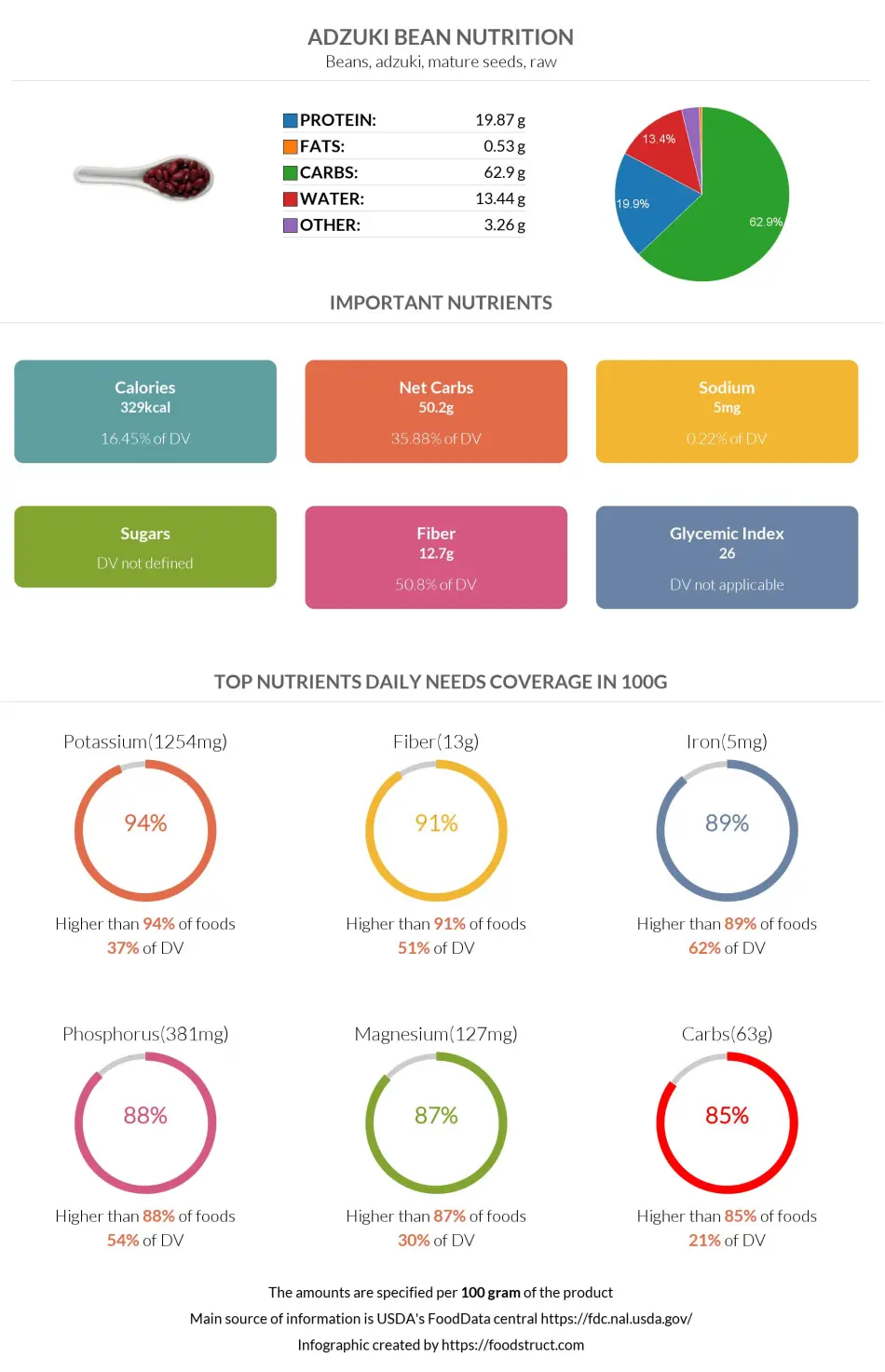
References
All the values for which the sources are not specified explicitly are taken from FDA’s Food Central. The exact link to the food presented on this page can be found below.

